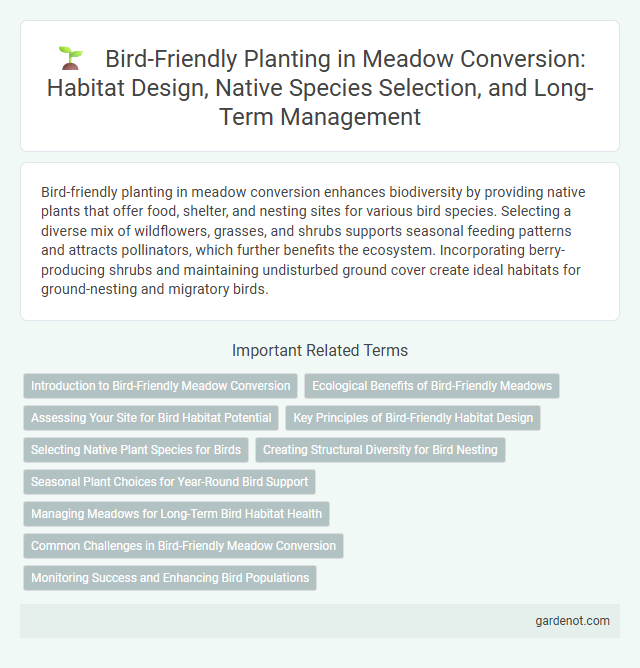Bird-friendly planting in meadow conversion enhances biodiversity by providing native plants that offer food, shelter, and nesting sites for various bird species. Selecting a diverse mix of wildflowers, grasses, and shrubs supports seasonal feeding patterns and attracts pollinators, which further benefits the ecosystem. Incorporating berry-producing shrubs and maintaining undisturbed ground cover create ideal habitats for ground-nesting and migratory birds.
Introduction to Bird-Friendly Meadow Conversion
Bird-friendly meadow conversion enhances biodiversity by creating habitats rich in native plants that attract and support local bird species. Incorporating a diverse mix of nectar-rich flowers, seed-producing grasses, and shelter-providing shrubs fosters nesting, foraging, and breeding opportunities for birds. This sustainable approach to landscaping reduces pesticide use and promotes ecological balance, benefiting both avian populations and overall ecosystem health.
Ecological Benefits of Bird-Friendly Meadows
Bird-friendly meadows provide essential habitats that support diverse avian species by offering abundant native plants, insect populations, and shelter critical for nesting and foraging. These meadows enhance local biodiversity by sustaining pollinators and natural pest controllers, contributing to a balanced ecosystem. Implementing bird-friendly planting promotes ecological resilience, improves soil quality, and aids in carbon sequestration, reinforcing the overall environmental health.
Assessing Your Site for Bird Habitat Potential
Evaluating your site for bird habitat potential involves identifying existing vegetation, available food sources, and shelter options that support local bird species in a meadow conversion project. Soil type, sunlight exposure, and water availability influence plant selection to attract and sustain diverse bird populations effectively. Incorporating native grasses and flowering plants enhances habitat suitability by providing nesting materials and feeding opportunities for birds.
Key Principles of Bird-Friendly Habitat Design
Bird-friendly habitat design in meadow conversion emphasizes diverse plant species selection, ensuring year-round food sources and shelter for avian wildlife. Incorporating native grasses and wildflowers supports insect populations crucial for bird diets while providing nesting materials. Structuring vegetation with varying heights and densities enhances habitat complexity, promoting breeding success and predator protection.
Selecting Native Plant Species for Birds
Selecting native plant species for bird-friendly meadow conversion enhances local biodiversity by providing essential habitats and food sources tailored to native bird populations. Native plants support diverse insect populations that serve as critical nourishment for nesting birds, improving breeding success rates. Prioritizing species with varying bloom times ensures a continuous supply of nectar, seeds, and shelter throughout the year, promoting sustainable bird communities.
Creating Structural Diversity for Bird Nesting
In meadow conversion projects, creating structural diversity through varied plant heights and densities is essential for bird nesting success. Incorporating native grasses, wildflowers, and shrubs provides shelter and camouflage, enhancing habitat suitability for ground-nesting and shrub-nesting bird species. This diverse vegetation structure supports a range of bird species by offering nesting materials, protection from predators, and microhabitats for breeding.
Seasonal Plant Choices for Year-Round Bird Support
Selecting native wildflowers and grasses with staggered bloom times ensures continuous nectar and seed availability, supporting diverse bird species throughout the year. Early spring blossoms like snowdrops and crocuses attract emerging pollinators, while summer coneflowers and asters provide critical seeds for finches and sparrows. Late-season berries from dogwood and sumac offer vital energy resources for migratory birds preparing for winter.
Managing Meadows for Long-Term Bird Habitat Health
Managing meadows for long-term bird habitat health requires strategic bird-friendly planting that includes native grasses, wildflowers, and shrubs supporting diverse insect populations essential for bird diets. Implementing rotational mowing schedules and maintaining structural diversity in vegetation ensures continuous availability of nesting sites and protective cover throughout seasons. Incorporating species such as coneflowers, goldenrods, and native sedges enhances forage opportunities for nesting birds, promoting sustained population growth and ecosystem resilience.
Common Challenges in Bird-Friendly Meadow Conversion
Common challenges in bird-friendly meadow conversion include selecting native plant species that provide adequate food and shelter throughout the year, balancing biodiversity with local ecosystem needs, and managing invasive species that threaten habitat quality. Ensuring continuous bloom periods and seed availability is critical to support diverse bird populations, while avoiding pesticide use protects avian health. Effective monitoring and adaptive management address these challenges by enhancing habitat suitability and promoting sustainable bird-friendly environments.
Monitoring Success and Enhancing Bird Populations
Monitoring success of bird-friendly meadow conversion involves regular surveys of bird species diversity and abundance, using both point counts and automated recording devices. Enhancing bird populations requires implementing native wildflower mixes that provide essential nectar and seeds, as well as maintaining a variety of vegetation structures for nesting and shelter. Data-driven adaptive management strategies ensure ongoing habitat improvements that support breeding success and attract migratory birds.
Bird-friendly planting Infographic

 gardenot.com
gardenot.com